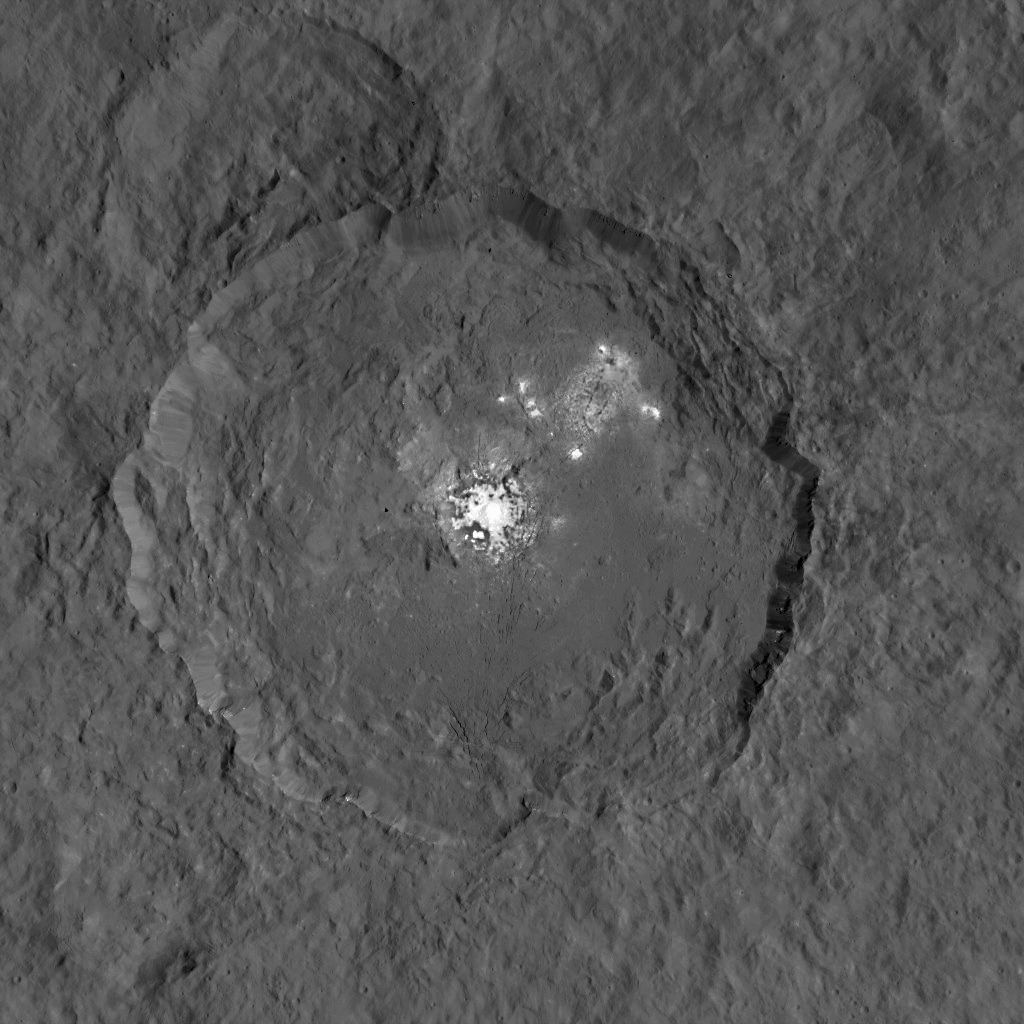Planets and Moons
ID: 30738

This image taken by NASA's Dawn spacecraft, shows Occator crater on Ceres, home to a collection of intriguing bright spots.
The bright spots are much brighter than the rest of Ceres' surface, and tend to appear overexposed in most images. This view is a composite of two images of Occator: one using a short exposure that captures the detail in the bright spots, and one where the background surface is captured at normal exposure.
The images were obtained by Dawn during the mission's High Altitude Mapping Orbit (HAMO) phase, from which the spacecraft imaged the surface at a resolution of about 450 feet (140 meters) per pixel.
Dawn's mission is managed by JPL for NASA's Science Mission Directorate in Washington. Dawn is a project of the directorate's Discovery Program, managed by NASA's Marshall Space Flight Center in Huntsville, Alabama. UCLA is responsible for overall Dawn mission science. Orbital ATK, Inc., in Dulles, Virginia, designed and built the spacecraft. The German Aerospace Center, the Max Planck Institute for Solar System Research, the Italian Space Agency and the Italian National Astrophysical Institute are international partners on the mission team. For a complete list of acknowledgments, see http://dawn.jpl.nasa.gov/mission.
For more information about the Dawn mission, visit http://dawn.jpl.nasa.gov.
Dawn Takes a Closer Look at Occator

The bright spots are much brighter than the rest of Ceres' surface, and tend to appear overexposed in most images. This view is a composite of two images of Occator: one using a short exposure that captures the detail in the bright spots, and one where the background surface is captured at normal exposure.
The images were obtained by Dawn during the mission's High Altitude Mapping Orbit (HAMO) phase, from which the spacecraft imaged the surface at a resolution of about 450 feet (140 meters) per pixel.
Dawn's mission is managed by JPL for NASA's Science Mission Directorate in Washington. Dawn is a project of the directorate's Discovery Program, managed by NASA's Marshall Space Flight Center in Huntsville, Alabama. UCLA is responsible for overall Dawn mission science. Orbital ATK, Inc., in Dulles, Virginia, designed and built the spacecraft. The German Aerospace Center, the Max Planck Institute for Solar System Research, the Italian Space Agency and the Italian National Astrophysical Institute are international partners on the mission team. For a complete list of acknowledgments, see http://dawn.jpl.nasa.gov/mission.
For more information about the Dawn mission, visit http://dawn.jpl.nasa.gov.
Credits
Amy Moran (Global Science and Technology, Inc.): Lead Animator
Please give credit for this item to:
NASA's Goddard Space Flight Center
NASA's Goddard Space Flight Center
Short URL to share this page:
https://svs.gsfc.nasa.gov/30738
Mission:
Dawn
Keywords:
SVS >> Hyperwall
SVS >> CERES
NASA Science >> Planets and Moons
SVS >> Presentation
SVS >> Dawn
https://svs.gsfc.nasa.gov/30738
Mission:
Dawn
Keywords:
SVS >> Hyperwall
SVS >> CERES
NASA Science >> Planets and Moons
SVS >> Presentation
SVS >> Dawn











